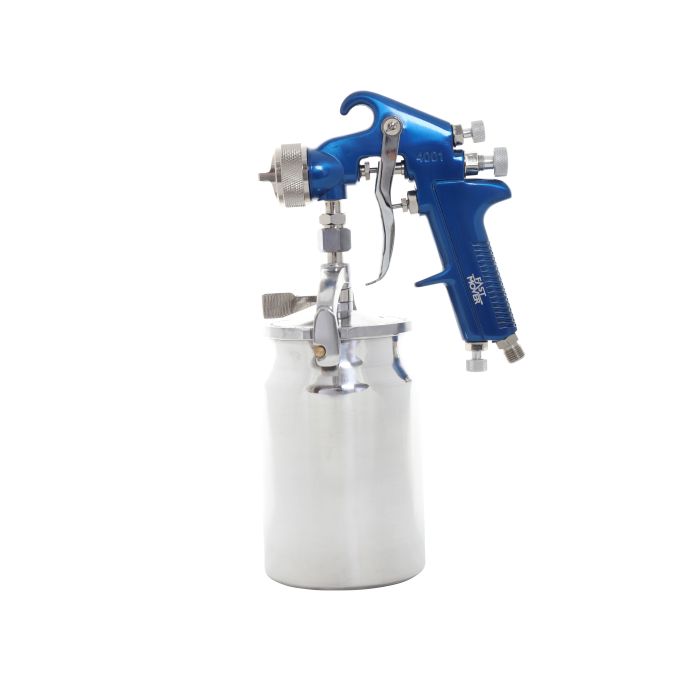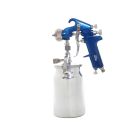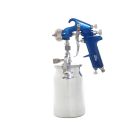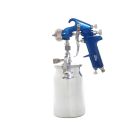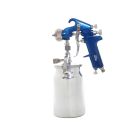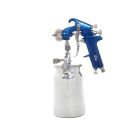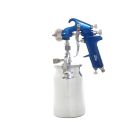|
Why use a Suction Spraygun Conventional
|
|
|
|
1. Excellent for Vertical and Overhead Surfaces
|
|
|
|
Why: The paint cup is located below the gun.
|
|
|
|
Benefit: Works well for spraying upward or sideways, making it ideal for tasks like painting ceilings, tall objects, or underside surfaces.
|
|
|
|
|
|
|
|
2. Consistent Material Feed
|
|
|
|
Why: Uses air pressure to create suction that draws paint from the cup.
|
|
|
|
Benefit: Ensures a steady and even flow of paint, even when the cup isn’t full or the angle changes slightly.
|
|
|
|
|
|
|
|
3. Great for Medium to Large Jobs
|
|
|
|
Why: Suction guns typically have larger paint cups (often 1L+).
|
|
|
|
Benefit: Reduces the need for frequent refills, making it suitable for cars, doors, panels, and furniture.
|
|
|
|
|
|
|
|
4. Superior Atomization and Finish Quality
|
|
|
|
Why: Conventional spray guns operate at higher pressure (typically 40–60 PSI).
|
|
|
|
Benefit: Delivers fine atomization, producing a smooth, professional-grade finish—ideal for automotive paint, clear coats, or lacquers.
|
|
|
|
|
|
|
|
5. Durable and Reliable Design
|
|
|
|
Why: Built with robust materials (aluminum, stainless steel needles, etc.).
|
|
|
|
Benefit: Stands up to regular use and a variety of materials like:
|
|
|
|
|
|
|
|
Solvent-based paints
|
|
|
|
Primers
|
|
|
|
Varnishes
|
|
|
|
Clear coats
|
|
|
|
|
|
|
|
6. Easy Maintenance and Cleaning
|
|
|
|
Why: The detachable cup and standard design make cleaning straightforward.
|
|
|
|
Benefit: Saves time in between jobs and helps avoid clogging or contamination.
|
|
|
|
|
|
|
|
7. Economical for Certain Jobs
|
|
|
|
Why: Simple design, no pressure pot or turbine required.
|
|
|
|
Benefit: A cost-effective choice for small to medium shops or DIYers with compressed air setups.
|
|
|
|
|
|
|
|
The benefits of a Suction Spraygun Conventional
|
|
|
|
1. Suction-Fed Design for Versatile Angles
|
|
|
|
Paint is drawn from a cup below the gun, allowing easier spraying at different angles.
|
|
|
|
Ideal for vertical, horizontal, and even upward surfaces (like ceilings or undersides of vehicles).
|
|
|
|
|
|
|
|
2. Excellent Finish Quality
|
|
|
|
Operates at higher pressure (typically 40–60 PSI) for better atomization.
|
|
|
|
Produces a smooth, fine finish ideal for:
|
|
|
|
|
|
|
|
Automotive refinishing
|
|
|
|
Wood furniture
|
|
|
|
Industrial coating work
|
|
|
|
|
|
|
|
3. Suitable for Medium to Large Projects
|
|
|
|
Usually fitted with a 1-liter paint cup, reducing the need for constant refilling.
|
|
|
|
Perfect for jobs involving:
|
|
|
|
|
|
|
|
Vehicle panels
|
|
|
|
Doors and cabinets
|
|
|
|
Large metal or wood surfaces
|
|
|
|
|
|
|
|
4. Simple, Durable Construction
|
|
|
|
Fewer moving parts compared to more complex spray systems.
|
|
|
|
Built from robust materials like aluminum or stainless steel for long-term use with solvent-based materials.
|
|
|
|
|
|
|
|
5. Reliable Paint Flow with Consistent Spray Pattern
|
|
|
|
Uses air pressure to pull paint upward, maintaining steady flow regardless of cup level (within reason).
|
|
|
|
Delivers a controlled, uniform spray pattern with minimal spitting or surging.
|
|
|
|
|
|
|
|
6. Easy to Clean and Maintain
|
|
|
|
Simple design makes it easy to disassemble and clean after use.
|
|
|
|
Reduces downtime between jobs and helps maintain long-term performance.
|
|
|
|
|
|
|
|
7. Cost-Effective for Shops with Air Compressors
|
|
|
|
Conventional suction spray guns are often more affordable than turbine or HVLP systems.
|
|
|
|
A great option for workshops already equipped with standard air compressors
|
|
|
|
|
|
|
|
Uses and applications of a Suction Spraygun Conventional
|
|
|
|
1. Automotive Refinishing
|
|
|
|
Use: Spraying base coats, clear coats, primers, and sealers.
|
|
|
|
Application: Ideal for vehicle panels, bumpers, and hard-to-reach surfaces.
|
|
|
|
Benefit: Excellent finish quality with good atomization, even for metallic or solvent-based paints.
|
|
|
|
|
|
|
|
2. Woodworking and Furniture Finishing
|
|
|
|
Use: Applying lacquers, stains, varnishes, or sealers.
|
|
|
|
Application: Chairs, tables, cabinets, and decorative wood items.
|
|
|
|
Benefit: Delivers a smooth, even coat over large or detailed wooden surfaces.
|
|
|
|
|
|
|
|
3. Industrial and Metal Fabrication
|
|
|
|
Use: Coating metal parts with primers, corrosion inhibitors, or enamels.
|
|
|
|
Application: Machinery, tools, equipment frames, or structural metal.
|
|
|
|
Benefit: Efficient for medium-scale industrial coating tasks with solvent-based products.
|
|
|
|
|
|
|
|
4. DIY and Home Improvement
|
|
|
|
Use: Painting doors, shutters, fences, or metal railings.
|
|
|
|
Application: Suited for users with a home air compressor setup.
|
|
|
|
Benefit: Provides a more professional finish than brushes or rollers, especially on textured surfaces.
|
|
|
|
|
|
|
|
5. Cleaning and Maintenance Applications
|
|
|
|
Use: Applying cleaning solutions or degreasers in mechanical and maintenance settings.
|
|
|
|
Application: Engines, machinery, tools.
|
|
|
|
Benefit: Controlled application of liquids with strong solvents or chemicals.
|
|
|
|
|
|
|
|
6. Specialty Coatings and Custom Projects
|
|
|
|
Use: Applying custom coatings, rubberized paint, or protective films.
|
|
|
|
Application: Used in hobbyist, artistic, or prototype fabrication settings.
|
|
|
|
Benefit: Versatile spray control for precision or decorative finishes.
|



